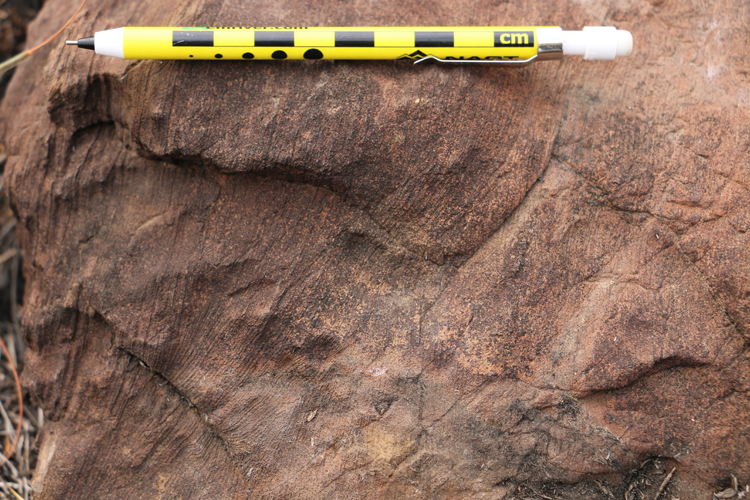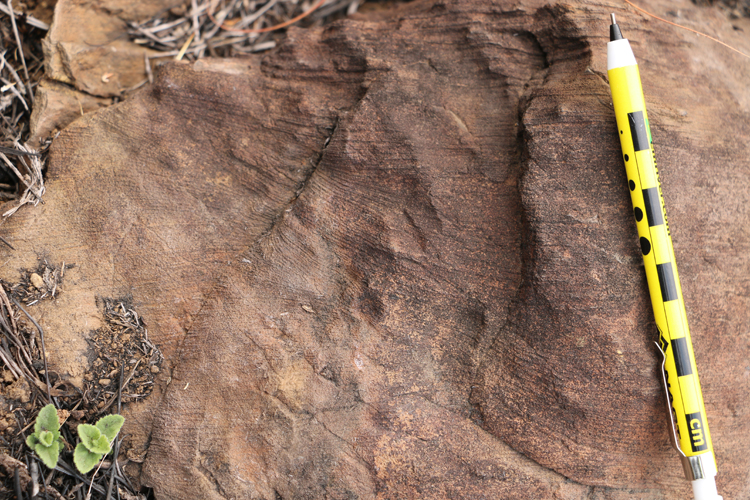5 June 2018
Cross-bedding in Archean komatiitic ash deposits
Posted by Callan Bentley
When I was learning about the Archean from the perspective of Barberton Mountain Land in South Africa, I was expecting to see komatiite lava flows. Early on in Earth history, the planet was hotter: (1) it was closer to the many thermokinetic impacts that built the planet from stone-cold meteorites, and (2) there were many more unstable radionuclides around, decaying and releasing their energy into the young planet. As a result, some minerals that don’t melt readily at modern volcanoes were able then to turn to liquid and ooze out of volcanoes at temperatures much higher than modern eruptions. As they crystallized, these lava flows grew “chandeliers” of spinifex textured olivine and pyroxene crystals.
However, I was not expecting to see primary sedimentary structures in these ash deposits. Some of the ultramafic volcanoes blew up, sending ash into the Archean atmosphere, from where it rained down as itty-bitty particles. In addition to accretionary lapilli and tsunamites (with accretionary lapilli!), the komatiite ash deposits show current flow indicators such as cross-beds, indicating they were moved around by currents of either air or water prior to final deposition:







These cross-beds are concave-up (like smiley faces), and if you’re astute, you’ll be able to find a few instances here where the top of the cross-beds are truncated by an overlying bed. Here’s a GIGAmacro example of that, with cross-bedding annotated in blue, and the bottom of the overlying bed in gray:
Note also the rusty patina of these ultramafic volcanic/sedimentary rocks – the olivine therein is ready to rust, even in the arid climate of South Africa.


 Callan Bentley is Associate Professor of Geology at Piedmont Virginia Community College in Charlottesville, Virginia. He is a Fellow of the Geological Society of America. For his work on this blog, the National Association of Geoscience Teachers recognized him with the James Shea Award. He has also won the Outstanding Faculty Award from the State Council on Higher Education in Virginia, and the Biggs Award for Excellence in Geoscience Teaching from the Geoscience Education Division of the Geological Society of America. In previous years, Callan served as a contributing editor at EARTH magazine, President of the Geological Society of Washington and President the Geo2YC division of NAGT.
Callan Bentley is Associate Professor of Geology at Piedmont Virginia Community College in Charlottesville, Virginia. He is a Fellow of the Geological Society of America. For his work on this blog, the National Association of Geoscience Teachers recognized him with the James Shea Award. He has also won the Outstanding Faculty Award from the State Council on Higher Education in Virginia, and the Biggs Award for Excellence in Geoscience Teaching from the Geoscience Education Division of the Geological Society of America. In previous years, Callan served as a contributing editor at EARTH magazine, President of the Geological Society of Washington and President the Geo2YC division of NAGT.
Dear Callan:
After posting your interesting blog about Cross-bedding in Archean komatiitic ash deposits, I received the following inquiries regarding their origin.
Can this deposit be the product of eroded komatiitic volcanic rocks instead of an ash deposit? If it is an ash deposit, do the fine layers represent episodic volcanic events or is the ash reworked in a marine environment that then produced the fine layering?
This is a great question. It’s my understanding that it’s the latter – that these are reworked by water.
Thanks for your response. Greatly appreciated.
These ashes may not have been deposited in the water… I think we have to see if the rock has hyalo character; if it does, it means that an aerial has been deposited… The Mg content is also important.